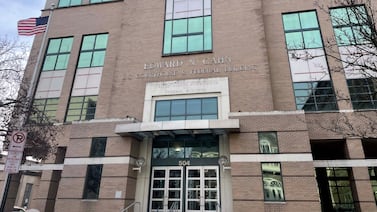This article is part of a yearlong reporting project focused on redistricting and gerrymandering in Pennsylvania. It is made possible by the support of Spotlight PA members and Votebeat, a project focused on election integrity and voting access.
HARRISBURG — What makes a political map fair?
It’s a question the people in charge of drawing Pennsylvania’s congressional and legislative boundaries wrestled with over the past year — with some major disagreements emerging in the process.
There are four traditional redistricting criteria spelled out in the state constitution. The districts must be compact, contiguous, and made up of roughly equal population, with counties, municipalities, and wards kept together unless splits are “absolutely necessary.”
But beyond those basic measures, lawmakers and state Supreme Court justices differed on what other criteria they should consider and prioritize, with perhaps the most debate over what’s known as “partisan fairness.”
The term has no standard definition, but it has been used in Pennsylvania to mean a map that doesn’t dilute the voting power of a person based on their political affiliation.
Democrats and good-government groups argued that it must be considered in order to satisfy the state constitution, while Republicans said the four traditional criteria — as well as Pennsylvania’s political geography and the map-drawing process — should be the deciding factors.
Ultimately, the state Supreme Court decided the issue. Democratic Gov. Tom Wolf rejected a congressional map sent to him by Republicans in the legislature, sending the decision to the high court. Those justices also had the final say on the constitutionality of the state House and Senate maps drawn by the Legislative Reapportionment Commission.
In the process, the majority endorsed partisan fairness as a key redistricting concept.
“Indeed, we conclude that consideration of partisan fairness, when selecting a plan among several that meet the traditional core criteria, is necessary to ensure that a congressional plan is reflective of and responsive to the partisan preferences of the commonwealth’s voters,” Chief Justice Max Baer, a Democrat, wrote in his opinion on the winning congressional map.
Below we break down the topic and lessons from this decade’s redistricting cycle.
What is partisan fairness?
Partisan fairness measures whether a map reflects the political leaning of a state using a combination of metrics. “Cracking” and “packing” — which describe when voting groups are broken apart and consolidated to manipulate voter power — are two ways to dilute a voter’s political power, and when this is done intentionally based on party affiliation, it is called partisan gerrymandering.
Take the Pennsylvania congressional map signed by former Republican Gov. Tom Corbett in 2011.
Despite statewide victories for Democratic candidates — like former President Barack Obama, who secured 52% of the vote in 2012 — Republicans consistently won 13 of Pennsylvania’s 18 congressional seats.
The League of Women Voters of Pennsylvania and a group of voters argued that the map was designed to “pack” Democrats into five districts and spread them out among the remaining 13.
The state Supreme Court threw out the map for that reason in 2018 and put in place a new one that created nine Democratic-leaning districts and nine Republican ones.
How is it measured?
Partisan fairness can be measured through an amalgamation of metrics that use past election data to predict results based on the proposed district lines.
Proportionality measures whether a map would produce a group of officials that reflects the state’s partisan divide. For example, if a party won 55% of the votes in a statewide election, then proportionally it would receive 55% of the seats.
Another measure assesses the difference between a party’s median vote share in each district and its average vote share. If a map is gerrymandered to pack one political party into a few districts where they win with high numbers while their remaining party members are spread across districts, comparing the average vote share to the median vote share will show a large difference. Typically, there shouldn’t be a large difference between the average and median numbers of votes a party receives across each district.
The efficiency gap measures how many votes each party wastes. If a district is packed or cracked, then a large number of a party’s votes will not contribute to its success, making the district inefficient. This number should be fairly similar for both parties. If one party has significantly more wasted votes than the other, that indicates gerrymandering.
Partisan bias looks at how many district seats a party would win if it receives exactly 50% of the statewide election. In a perfectly proportional map, a party would win 50% of the seats. If a party were to win 60% of the seats, then the proposed map would have a 10% bias in favor of that party.
These metrics are taking on an increasingly important role in rulings as state courts adjudicate disputes about gerrymandering.
In 2018 and 2022, the Pennsylvania Supreme Court accepted testimony from academics who measured partisan fairness using some of these metrics, as did high courts in other states like North Carolina and Ohio.
What is the Pennsylvania Supreme Court’s position on partisan fairness?
At the heart of the 2018 ruling throwing out a previous congressional map is the free and equal elections clause of the state constitution, which guarantees that each vote has the same amount of power.
“For our form of government to operate as intended, each and every Pennsylvania voter must have the same free and equal opportunity to select his or her representatives,” Justice Debra Todd wrote on behalf of the majority.
In the same ruling, Todd, a Democrat, wrote, “It is axiomatic that a diluted vote is not an equal vote, as all voters do not have an equal opportunity to translate their votes into representation.”
The exact term “partisan fairness” appears nowhere in the ruling, but some petitioners in the recent case over the congressional map argued that it must be considered to satisfy the elections clause and prevent vote dilution.
“The Supreme Court has mandated that, in addition to evaluating a plan’s compliance with the traditional redistricting criteria, the Court must also evaluate whether a plan will nonetheless operate to unfairly dilute the power of a particular group’s vote for a congressional representative,” counsel for the Gressman petitioners — a group of math and science professors from Pennsylvania — wrote in a filing. “The parties in this case refer to this principle as ‘partisan fairness.’”
That interpretation was essentially confirmed in Baer’s ruling.
“Partisan fairness metrics provide tools for objective evaluation of proposed congressional districting plans to determine their political fairness and avoid vote dilution based on political affiliation,” the justice wrote on behalf of the majority.
What does the GOP say about partisan fairness?
In legal filings concerning both the congressional and legislative plans, state Republicans argued that valuing partisan fairness amounts to gerrymandering and that the “natural political geography” of Pennsylvania favors Republican voters.
Because Democratic voters tend to live clustered in urban and suburban areas, district maps naturally have a Republican bias, they argued.
“Call it proportionality, call it responsiveness, call it partisan fairness,” said Matthew Haverstick, counsel for U.S. Rep. Guy Reschenthaler (R., Pa.). “I believe these are all code words for another way of saying gerrymandering.”
House Majority Leader Kerry Benninghoff (R., Centre) made similar arguments in his legal challenge to the state House and Senate maps. He voted against the plan as a member of the five-person Legislative Reapportionment Commission.
He described the maps as a “Democratic gerrymander” because they “carve[d] up the commonwealth’s cities to spread out Democratic-leaning urban voters into suburban and exurban areas to dilute the votes of Republican-leaning voters.”
“The commission cannot unnecessarily split counties or municipalities to artificially increase the number of Democratic-leaning districts, even if the alleged goal of doing so is to achieve a more ‘proportional’ or ‘symmetrical’ seat share relative to the statewide two-party vote share or to negate a natural geographic disadvantage,” his attorneys argued in a brief to the state Supreme Court.
Mark Nordenberg, the nonpartisan chair of the Legislative Reapportionment Commission, defended the maps against accusations of partisan gerrymandering, saying they properly reflected changes in the state’s makeup.
“Most basically, a fair map should be responsive to voters’ preferences,” he wrote in a report to the state Supreme Court. “One party should not have entrenched political power that is so strong as to not reflect the actual votes of the citizens of Pennsylvania.”
The state Supreme Court rejected Benninghoff’s challenge, as well as several others, but did not explain its reasoning.




